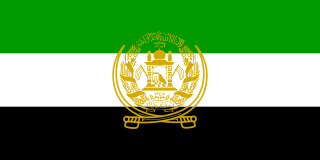Related Research Articles

Ahmad Shah Massoud was an Afghan politician and military commander. He was a powerful guerrilla commander during the resistance against the Soviet occupation between 1979 and 1989. In the 1990s, he led the government's military wing against rival militias; after the Taliban takeover, he was the leading opposition commander against their regime until his assassination in 2001.

Burhānuddīn Rabbānī was an Afghan politician and teacher who served as President of Afghanistan from 1992 to 1996, and again from November to December 2001.

Gulbuddin Hekmatyar is an Afghan politician, former mujahideen leader and drug trafficker. He is the founder and current leader of the Hezb-e-Islami Gulbuddin political party, so called after Mohammad Yunus Khalis split from Hezbi Islami in 1979 to found Hezb-i Islami Khalis. He has twice served as Prime Minister during the 1990s.

This article on the history of Afghanistan covers the period from the fall of the Najibullah government in 1992 to the end of the international military presence in Afghanistan.

The Islamic State of Afghanistan was established by the Peshawar Accords of 26 April 1992. Many Afghan mujahideen parties participated in its creation, after the fall of the socialist government. Its power was limited due to the country's second civil war, which was won by the Taliban, who took control of Kabul in 1996. The Islamic state then transitioned to a government in exile and led the anti-Taliban Northern Alliance. It remained the internationally recognized government of Afghanistan at the United Nations until 2001, when the Transitional Islamic State of Afghanistan was created and an Afghan Interim Administration took control of Afghanistan with US and NATO assistance following the overthrow of the first Taliban government. The Transitional Islamic State was subsequently transformed into the Islamic Republic, which existed until the Taliban seized power again in 2021 following a prolonged insurgency.

Jamayat-E-Islami, sometimes shortened to Jamiat, is a predominantly Tajik political party and former paramilitary organisation in Afghanistan. It was originally formed as a student political society at Kabul University. It has a communitarian ideology based on Islamic law. During the Soviet–Afghan War and the following Afghan Civil War against the communist government, Jamiat-e Islami was one of the most powerful of the Afghan mujahideen groups. Burhanuddin Rabbani led the party from 1968 to 2011, and served as President of the Islamic State of Afghanistan from 1992 to 2001, in exile from 1996.

The Northern Alliance, officially known as the United Islamic National Front for the Salvation of Afghanistan, was a military alliance of groups that operated between early 1992 and 2001 following the dissolution of the Soviet Union. At that time, many non-Pashtun Northerners originally with the Republic of Afghanistan led by Mohammad Najibullah became disaffected with Pashtun Khalqist Afghan Army officers holding control over non-Pashtun militias in the North. Defectors such as Rashid Dostum and Abdul Momim allied with Ahmad Shah Massoud and Ali Mazari forming the Northern Alliance. The alliance's capture of Mazar-i-Sharif and more importantly the supplies kept there crippled the Afghan military and began the end of Najibullah's government. Following the collapse of Najibullah's government the Alliance would fall with a Second Civil War breaking out however following the Islamic Emirate of Afghanistan's (Taliban) takeover of Kabul, The United Front was reassembled.
Hajii Sher Alam Ibrahimi was the governor of Ghazni Province from around 2005–2006 until 2007 and is a major commander aligned with Ittihad-i Islami and Abdul Rasul Sayyaf, having fought with him in the Afghan Civil War.

The 1989–1992 Afghan Civil War, also known as the FirstAfghan Civil War, took place between the Soviet withdrawal from Afghanistan and the end of the Soviet–Afghan War on 15 February 1989 until 27 April 1992, ending the day after the proclamation of the Peshawar Accords proclaiming a new interim Afghan government which was supposed to start serving on 28 April 1992.

The 1992–1996 Afghan Civil War, also known as the Second Afghan Civil War, took place between 28 April 1992—the date a new interim Afghan government was supposed to replace the Republic of Afghanistan of President Mohammad Najibullah—and the Taliban's conquest of Kabul establishing the Islamic Emirate of Afghanistan on 27 September 1996.

The 1996–2001 Afghan Civil War, also known as the Third Afghan Civil War, took place between the Taliban's conquest of Kabul and their establishing of the Islamic Emirate of Afghanistan on 27 September 1996, and the US and UK invasion of Afghanistan on 7 October 2001: a period that was part of the Afghan Civil War that had started in 1989, and also part of the war in Afghanistan that had started in 1978.

National Islamic Front of Afghanistan is a political party in Afghanistan. It has been led, since its founding, by members of a prominent Sufi family, the Gailani. It is primarily a Pashtun party, followers of the Sufi holy man Pir Sayed Ahmed Gailani have a reputation for moderate thought and the traditional mystical and introspective religious currents that characterize Sufism in that sect.
The Afshar Operation was a military operation in Afghanistan that took place on February 11–12, 1993 during the Afghan Civil War (1992-96). The operation was launched by Ahmad Shah Massoud and Burhanuddin Rabbani's Islamic State of Afghanistan government and the allied Abdul Rasul Sayyaf's Ittehad-i Islami paramilitary forces against Gulbuddin Hekmatyar's Hezbe Islami and Abdul Ali Mazari's Hezbe Wahdat militias in the densely populated, Qizilbash-majority, Afshar district in west Kabul. The Hazara-Hezbe Wahdat together with the Pashtun-Hezbe Islami of Hekmatyar had been shelling densely populated areas in northern Kabul from their positions in Afshar, killing thousands. To counter the shelling, government forces attacked Afshar in order to capture the positions of Wahdat and its leader Mazari, and to consolidate parts of the city controlled by the government.

The Battle of Kabul was a series of intermittent battles and sieges over the city of Kabul during the period of 1992–1996.

Saydabad District is a district of Maidan Wardak Province, Afghanistan. The district is known for its pleasant climate, including hilly vegetation, streams, and orchards. The district was a popular retreat for Kabul residents until an increase in ISAF-Taliban violence in the late 2000s. The city of Saydabad serves as the district capital. With a population of 114,793, it is the most populous district of the province.

Baba Jan zahid, is a former senior security official of the Afghanistan government. He was a general of the Democratic Republic of Afghanistan, but after the Soviet invasion he joined Ahmad Shah Masoud's forces and fought against the Soviet invasion. After the retreat of the Russian forces, he continued the war against Dr. Najibullah's government. Following the collapse of Najib's government, he entered Kabul with Ahmad Shah Masoud's forces and served in various departments of the Islamic State of Afghanistan under the leadership of Ustad Burhanuddin Rabbani.
Baba Jalandar Panjshiri was a commander of Jamiat-e Islami during the Soviet invasion of Afghanistan and Civil War in Afghanistan. He was one of the senior commanders of Ahmed Shah Massoud and participated in the fighting that took place in Kabul from 1992 to 1996 between Government forces and militia of Gulbuddin Hekmatyar and Hezbe wahdat to control the capital, Along with Gul Haidar he took 3-month rotations in charge of the artillery located on top T.V. Mountain in Kabul against the opposition offensive toward Kabul. Units under his command were also involved in the Afshar Operation according to a Human Rights Watch report. The same report also stated that he commanded a brigade into Afshar during the assault.

The National Islamic Movement of Afghanistan, sometimes called simply Junbish, was a Turkic political party in Afghanistan. Its founder is Marshal Abdul Rashid Dostum who created it in 1992 made from his loyalist remnants from the People's Democratic Party of Afghanistan's communist regime.

The Shura-e Nazar was created by Ahmad Shah Massoud in 1984 at the northern provinces of Takhar, Badakhshan, Balkh and Kunduz, during the Soviet-Afghan War. It comprised and united about 130 resistance commanders from 12 northern, eastern and central regions of Afghanistan.

Saudi Arabia has historically exerted a strong influence on Afghanistan and was one of the major providers of funds to the Afghan mujahideen who were fighting against the Soviets and their allies the DRA. Saudi Arabia was also the second of only three countries to recognize the first Taliban government, extending official recognition on 26 May 1997, one day after Pakistan and shortly before the United Arab Emirates. After the 2001 invasion of Afghanistan, Saudi Arabia was one of the major helpers in the Afghan reconstruction. For example, the main highway project was funded mainly by the United States and Saudi Arabia. The Grand Mosque of Kabul in Afghanistan was also financed by Saudi Arabia.
References
- ↑ Immigration and Refugee Board of Canada, Afghanistan: The role of Commander Anwar Dangur (Dangar) in the Jamiat-e-Islami in Kabul, and subsequently in the Taliban, which he joined following the 27 September 1996 Taliban conquest of the capital, 1 April 1998, AFG29150.E, available at: http://www.unhcr.org/refworld/docid/3ae6ab2364.html [accessed 24 November 2009]
- ↑ Afghanistan Justice Project. "Casting Shadows: War Crimes and Crimes Against Humanity, 1978-2001." 2005. Accessed at: http://www.afghanistanjusticeproject.org/ [Accessed on 10 November 2009]
- ↑ Afghanistan News Service 2 August 1997
- ↑ UN Security Council, The situation in Afghanistan and its implications for international peace and security Report of the Secretary-General, 19 April 2001, S/2001/384, available at: http://www.unhcr.org/refworld/docid/3aefcb7a4.html [accessed 24 November 2009]
- ↑ Palmer, James. "Afghan troops prepare for attack on Mullah Omar's 'mountain hideout'" 18 December 2001. Accessed at: [ dead link ]
- ↑ India News Online. Afghanistan: Karzai takes over: Fall of Tora Bora. Accessed at:
- ↑ Korgun, Victor. "Afghanistan's Resurgent Taliban." The Jamestown Foundation. 24 October 2003. Accessed at: http://www.jamestown.org/single/?no_cache=1&tx_ttnews[tt_news]=18975
- ↑ Giustozzi, Antonio. "Koran, Kalashnikov and Laptop." HURST Publishers, Ltd. London. (1996), pg 90.